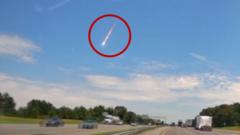
Spectacular Bolide Event Creates Sonic Boom, Lights Up Skies
Witnesses across several states reported a dazzling celestial event last night, describing a brilliant fireball streaking across the sky, accompanied by a loud sonic boom. Preliminary analysis indicates the phenomenon was a bolide, a particularly large and rare type of meteor that enters Earth's atmosphere.
What is a Bolide?
The American Meteor Society defines a bolide as a fireball that is exceptionally bright, often exploding in the atmosphere. Unlike typical meteors, which are often small particles of dust or ice, bolides are significantly larger, ranging in size from a basketball to several meters in diameter. This larger size allows them to penetrate deeper into the atmosphere before completely burning up, often resulting in a fragmentation event and a noticeable sonic boom.
Eyewitness Accounts and Reports
Social media platforms were flooded with reports and videos as the event unfolded. Many described seeing a bright, green or orange flash, followed by a rumbling sound minutes later. One user on X (formerly Twitter) wrote, "It looked like daylight for a split second! Then the house shook!" Another user reported, "I thought it was thunder, but the sky was perfectly clear."
The Science Behind the Boom
The sonic boom associated with a bolide is a result of the object traveling through the atmosphere at supersonic speeds. As the bolide hurtles through the air, it compresses the air in front of it, creating a shock wave. This shock wave propagates outwards in all directions, and when it reaches the ground, it is perceived as a loud bang or rumble. The intensity of the sonic boom depends on the size, speed, and altitude of the bolide.
Rarity and Significance
While meteors are relatively common occurrences, bolide events are far less frequent. Their large size and dramatic entry make them particularly noteworthy for both scientists and the general public. Studying bolides can provide valuable insights into the composition of asteroids and comets, as well as the dynamics of the Earth's atmosphere.
Possible Meteorite Fragments
Given the reported size and brightness of the bolide, there is a possibility that fragments of the object may have survived the atmospheric entry and landed on the ground as meteorites. If you believe you have found a potential meteorite, it is recommended to:
- Take detailed photographs of the object and its surroundings.
- Record the GPS coordinates of the location where it was found.
- Avoid handling the object excessively to prevent contamination.
- Contact a local university's geology or astronomy department, or a reputable meteorite organization for identification.
Reporting Your Sighting
The American Meteor Society encourages anyone who witnessed the event to report their sighting on their website. These reports are valuable for determining the bolide's trajectory, speed, and estimated size. The information gathered can also help in the search for potential meteorite fragments.
Ongoing Research
Scientists are currently analyzing data from weather satellites, radar systems, and eyewitness accounts to reconstruct the bolide's trajectory and estimate its size and composition. Further updates will be provided as more information becomes available.
Related Resources
- American Meteor Society: https://www.amsmeteors.org/
- NASA Meteor Watch: https://www.nasa.gov/mission_pages/asteroids/overview/index.html
